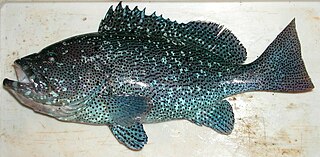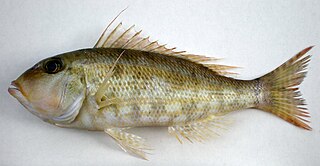Spicules are any of various small needle-like anatomical structures occurring in organisms
Secernentea was a class of nematodes in the Classical Phylogeny System and is no longer in use. This morphological-based classification system has been replaced by the Modern Phylogeny system, where taxonomy assignment is based on small subunit ribosomal DNA.
Habronema muscae is an internal stomach parasite that is most commonly found in horses. It is in genus Habronema.
Dichelyne alatae is a species of nematode, described on the basis of the worms recovered from the intestine of the whiting, Sillaginopsis panijus from the estuary of the Hooghly River at Kalyani, West Bengal, India. Dichelyne alatae is unique in having a small body size, deirids posterior to the oesophagus, short and wide caudal alae at the level of cloacal opening, unequal, alate spicules, a shield-shaped gubernaculum, a different number of caudal papillae and a conical tail with spines in its distal region.

The nematodes or roundworms constitute the phylum Nematoda. They are a diverse animal phylum inhabiting a broad range of environments. Taxonomically, they are classified along with insects and other moulting animals in the clade Ecdysozoa, and unlike flatworms, have tubular digestive systems with openings at both ends.

Mermithida is an order of nematode worms. The order includes two families, and most members are endoparasites on arthropods. One of the morphological characteristic of the order is the presence of a stichosome.
Skrjabinoclava kinsellai is a parasitic nematode worm that infects the marsh rice rat in Florida.
Mononchoides is a quite common genus in the phylum of the Nematoda and by far the most diverse genus of the family of the Diplogastridae. It has been described to live in various terrestrial habitats and is often associated with compost, dung, mud, other decaying materials and different kinds of beetles. Some have even been described from fresh water and marine habitats. In 2011, a new species has been described by Steel et al. This species was isolated from compost during the composting process and was named Mononchoides composticola.
Paracapillaria xenentodoni is a parasitic nematode present in the migratory fish Xenentodon cancila. It has been observed in India.

The Trichosomoididae is a family of nematodes.
Hoplolaimus galeatus is a plant pathogenic nematode.
Paragendria papuanensis is a species of nematode parasite. It parasitises freshwater fishes from Papua New Guinea, particularly Glossamia gjellerupi and Melanotaenia affinis.
Dolichodorus is a genus of nematodes known commonly as awl nematodes. They are distributed worldwide. They are ectoparasites of plant roots, and some are pests of agricultural crops.

In nematodes (roundworms), spicules, or copulatory spicules, are needle-like mating structures found only in males.
Philometra priacanthi is a species of parasitic nematode of fishes. Its name is derived from its host species, Priacanthus hamrur. It possesses dorsal lamella-like structures on the distal part of its gubernaculum, which can also be found on other of its cogenerates. The only species with a dorsal protuberance near the gubernaculum's end is P. priacanthi, however. P. lateolabracis can be distinguished from the former by the lateral caudal mounds separated dorsally, narrower lamella-like structures on its gubernaculum, shorter spicules, and by the testis extending anteriorly. Other gonad-infecting species differ from this one by possessing a smooth gubernaculum, and their spicules being of different lengths. Seven gonad-infecting species of Philometra can be distinguished from P. priacanthi by their host types, as well as by geographical distribution.

Philometra cyanopodi is a species of parasitic nematode of fishes, first found off New Caledonia in the South Pacific, in the gonads of Epinephelus cyanopodus. This species is characterized mainly by: length of spicules and length and structure of its gubernaculum; structure of male caudal end; body size; location in host and types of hosts.

Philometra lethrini is a species of parasitic nematode of fishes, first found off New Caledonia in the South Pacific, in the gonads of Lethrinus genivittatus. This species is characterized mainly by: length of spicules and length and structure of its gubernaculum; structure of male caudal end; body size; location in host and types of hosts.
Philometra lagocephali is a species of parasitic nematode of fishes, first found off New Caledonia in the South Pacific, in the abdominal cavity of Lagocephalus sceleratus. This species is characterized mainly by: length of spicules and length and structure of its gubernaculum; body size; location in host and types of hosts.

Philometra fasciati is a species of parasitic nematode of fishes, first found off New Caledonia in the South Pacific, in the gonads Epinephelus fasciatus. This species is characterized mainly by: length of spicules and length and structure of its gubernaculum; structure of male caudal end; body size; location in host and types of hosts.
Philometroides eleutheronemae is a species of parasitic nematode of fishes, infecting the gonads of marine perciform fishes off the eastern Indian coast. It was first found in the fourfinger threadfin, Eleutheronema tetradactylum. It is distinguished from its cogenerates by the gubernaculum structure in males, as well as the shape and structure of the females' cephalic and caudal ends, and their oesophagus.












